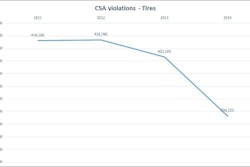I’m always grateful when I get my hands on fresh data about the fleet and owner-operator marketplace.
Obviously a majority of my time, like yours, is dedicated to addressing the news and issues facing businesses in the independent aftermarket. I spend a great deal of time learning about this industry, uncovering its strengths and weaknesses; its best growth opportunities and its short- and long-term challenges. I want to know this industry inside and out, so I can provide the best information possible to those of you who populate it.
But too much time focused solely on one area can have its flaws. Tunnel vision can cause you to miss tertiary information — some of which can be very valuable.
Which leads me to the annual Commercial Carrier Journal 2016 Reader Profile survey. CCJ, sister publication of Truck Parts & Service, conducts a Reader Profile survey that asks a sampling of its expansive readership of fleet representatives about the state of their businesses, and their goals for the coming year.
It provides good insight into that market, and sometimes I uncover a nugget or two of information I can share with you.
This year that nugget is safety.
Nearly half of fleet responders (46.5 percent) to CCJ’s 2016 Reader Profile survey answered that they plan to make “significant information technology investments this year” in safety and risk management. That number was nearly ten percentage points above all the other responses to the question.
So, how can you sell safety? How can you provide products, services and technology to appeal to this large cross-section of your customer base?
“Information technology” is an ambiguous term. One I’m sure each fleet responder viewed differently when answering that question. Maybe some of the responders are planning to purchase additional telematics systems when they place their next new truck order. Others may be planning to purchase more vehicle monitoring capabilities through the systems they already have. And of course there’s also a chance some responders plan to add new safety technology to their existing assets.
The National Highway Transportation Safety Administration (NHTSA) mandated Reduced Stopping Distance (RSD) on new vehicles in 2012 and is gearing up to make Electronic Stability Control (ESC) a requirement in 2017. Combine that with the lane departure warning, collision mitigation and truck platooning systems also entering the market, it’s clear that safety is priority No. 1 to your customers. Make it a point of emphasis with your vendors.
Make sure they’re keeping you informed about the new safety products they’re debuting in the OE channel. Make sure you know how long the technology has been available and when it is due to arrive (or did arrive) in the aftermarket.
Then cross reference that equipment with your customer base. What do you need to stock today, and what can you afford to wait on?
The ESC mandate will apply to trucks built after Aug. 1, 2017. Some OEMs and fleets have proactively adopted the ESC technology ahead of the deadline, but it’s unlikely ESC needs to be a priority for you today.
The RSD mandate, however, is nearly four years old. If you consider yourself a premium distributor, there’s no reason you shouldn’t be stocking RSD lines. Fleet customers who replace like-for-like will be coming to you for RSD parts any day now. Don’t let them down.
The safety push isn’t going away.
The Federal Motor Carrier Safety Administration (FMCSA) is revamping but not discarding its Compliance Safety Accountability program, and the ease with which NHTSA implemented the RSD and ESC mandates leads me to believe more are sure to come.
Selling safety in trucking is booming. Go get your share of the pie.










